 W
WAizkraukle Castle is a ruined medieval castle, located on the right bank of the river Daugava in Latvia to the west of the modern town of Aizkraukle. The castle was built in the second half of the 14th century by the Livonian Order. From 1334 to 1480 it was the seat of a Komtur.
 W
WAizpute Castle is a Livonian Order castle in the town of Aizpute in the historical region of Courland, in western Latvia. It was heavily damaged during the Second Northern War (1655–1660). Since 1998, the castle ruins are a Latvian historical monument.
 W
WAlsunga Castle is a castle in Alsunga village, in the historical region of Courland, in western Latvia. It was built for the Livonian Order during the first half of the 14th century.
 W
WAlūksne Castle is a castle of Teutonic Knights in current Alūksne, North-Eastern Latvia.
 W
WBauska Castle is a complex consisting of the ruins of an earlier castle and a later palace on the outskirts of the Latvian city of Bauska.
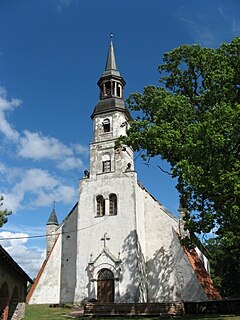 W
WBurtnieki is a village in Burtnieki Parish, North Latvia, near Lake Burtnieks. Administrative centre of Burtnieki Municipality. Burtnieki was first mentioned in Indrikis chronicles in 1208 and has several historic sites: Burtnieki castle-ruins, Burtnieki manor and Burtnieki church.
 W
WBurtnieki Castle is a castle in the historical region of Vidzeme, in northern Latvia. It was built on the south shore of Lake Burtnieks for the Livonian Order around 1284.
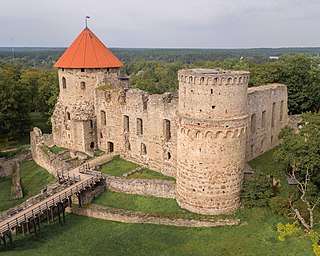 W
WCēsis Castle is one of the most iconic and best preserved medieval castles in Latvia. The foundations of the castle were laid 800 years ago by the Livonian Brothers of the Sword. The most prosperous period Cēsis Castle experienced was during its next owners, the Teutonic Order. It became one of the key administrative and economic centers of the Teutonic Order in Livonia and was a seat of Landmeister in Livland. The first serious damage was done to the castle during the Livonian War, when it was besieged by the army of Ivan the Terrible. In the course of the siege of 1577 approximately 300 people within the castle committed mass suicide by blowing themselves up with gunpowder. Cēsis Castle was still in use during the following century but it fell into disuse after the Great Northern War. Today the castle is the most visited heritage site in Cēsis and one of the 'must see' destinations in the Baltic states.
 W
WDaugavgrīva Castle is a former monastery converted into a castle, located at Vecdaugava oxbow on right bank of Daugava, in the northern part of Riga city, Latvia. Nowadays here are seen only earthen ramparts.
 W
WDinaburga Castle, also known as Vecdaugavpils or Vecpils, is a castle located in Naujene parish east of Daugavpils, in the historical region of Latgale, in eastern Latvia. It is strategically situated on a high bank of the Daugava River. It was built between 1273 and 1277 by the Livonian Order, and destroyed by Russian troops before 1577. Nowadays, fragments of the foundation are exposed.
 W
WDobele Castle is a castle in the town of Dobele on the west bank of the river, in the historical region of Zemgale, in Latvia. Dobele was built in 1335 by the Livonian order on top of a more ancient castle.
 W
WDundaga Castle is a medieval castle in Dundaga, Latvia, in the Dundaga municipality. Latvia considers Dundaga Castle to be a monument of archaeological and of architectural importance.
 W
WGaujiena Castle is a castle in the historical region of Vidzeme, in northern Latvia. It was built between 1236 and 1238. Severely damaged in 1702 during the Great Northern War, the structure was abandoned.
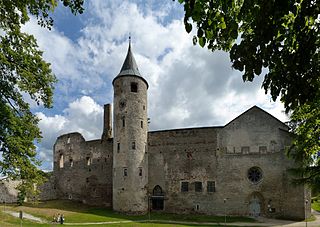 W
WHaapsalu Castle is a castle with cathedral in Haapsalu, Estonia, founded in the thirteenth century as the seat of the Bishopric of Ösel-Wiek. According to legend, during full moons in August, an image of a maiden, The White Lady, appears on the inner wall of the chapel.
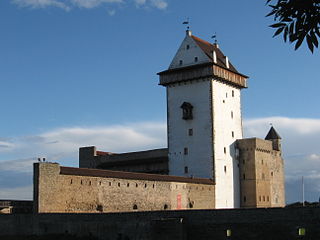 W
WHermann Castle (also Hermannsfeste, Herman Castle, Narva Castle, and Narva fortress. is a castle in Narva, eastern Estonia. It was founded in 1256 by the Danes and the first stone castle was built in the beginning of the 14th century. The German Livonian Order purchased the castle on 29 August 1346, and owned it for much of its history.
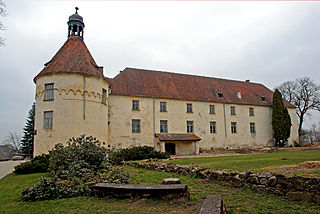 W
WJaunpils Castle is a castle in the historical region of Zemgale, in Latvia. More of a manor house than properly a fortified castle, it has now been converted into a hotel.
 W
WKoknese Castle is a complex in Koknese, Latvia, dating from the 13th century. The castle was situated on a high bluff overlooking the Daugava river valley. In 1965 a hydroelectric dam was built downriver, creating a reservoir that partially submerged the castle and flooded the surrounding valley.
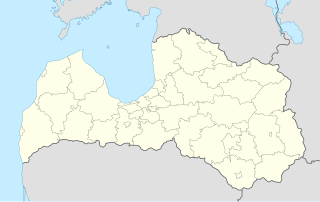 W
WKuldīga Castle also Goldingen Castle and Jesus Castle was a medieval castle of the Livonian Order in historical Courland in town Kuldīga near Venta Rapid. Today on the left bank of the Venta at the end of the old bridge one can find the former castle mill, a castle guard's house and a city park with the castle ruins on Rumba Hill.
 W
WLaiuse is a small borough in Estonia. It is located in Jõgeva County and is a part of Jõgeva Parish. As of 2011 Census, the settlement's population was 371.
 W
WLaiuse Castle was a Livonian Order castle in Laiusevälja, Jõgeva Parish, Estonia. The castle is now in ruins.
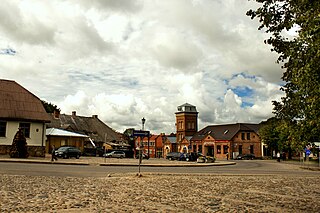 W
WLimbaži is a town in the Vidzeme region of northern Latvia. Limbaži is located 90 km northeast of the capital Riga. The population is 8705 people. During the Middle Ages, as part of Livonia, Limbazi was a fortified town with stone walls, second in importance only to Riga.
 W
WLudza Castle was a medieval castle built in Gothic style located next to a Catholic church, on the site of a former Latgalian wooden castle in the centre Ludza, Latvia, a small town in eastern Latgale. Its main purpose was to be an eastern outpost to control trade routes from Russia. Nowadays the impressive fragments of the castle walls, including a three-floor high fragment, still remain. The ruins are the main tourist attraction in the Ludza District, and is considered a symbol of the town.
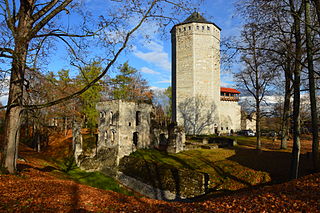 W
WPaide is a small city and the capital of Järva County, Estonia.
 W
WRakvere is a town in northern Estonia and the capital of Lääne-Viru County, 20 km south of the Gulf of Finland of the Baltic Sea. Until early 20th century Rakvere was more widely known by its historical German name Wesenberg(h).
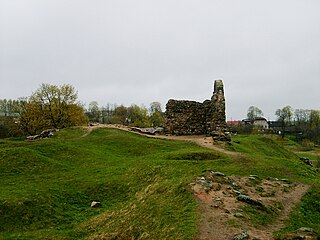 W
WRēzekne Castle ruins are located in the downtown of Rēzekne, Latvia, a city in the center of Latgale. The castle served as a base of the local Livonian order landlords until the 16th century and also as the main military support base for battles against Russians and Lithuanians. Today, fragments of the stone walls and the foundation can be seen on the ancient castle hill.
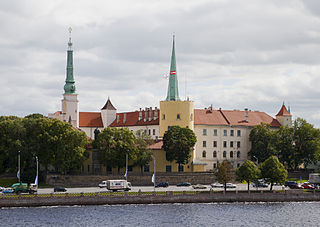 W
WRiga Castle is a castle on the banks of River Daugava in Riga, the capital of Latvia. The castle was founded in 1330. Its structure was thoroughly rebuilt between 1497 and 1515. Upon the castle's seizure by the Swedes, they constructed spacious annexes in 1641. The fortress was continually augmented and reconstructed between the 17th and 19th centuries. Sometime in the 1930s, some renovation work was done by architect Eižens Laube. The Latvian government declared the castle its residence in 1938. Today it is the official residence of the President of Latvia as well as home to several museums.
 W
WThe ruins of the hill castle Rujiena Castle are located on the edge of today's village Rūjiena on the right bank of the Rūja river in Latvia.
 W
WSēlpils Castle is an ancient castle in Latvia.
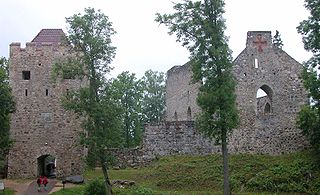 W
WSigulda Medieval Castle ruins are located on the edge of the Gauja valley in Latvia. The original castle was built in 1207 as a castellum type fortress, later rebuilt into a convent type building. The residence of the Land Marshal of the Livonian Order since 1432.
 W
WTērvete is a village in Tērvete Municipality, Latvia, famous for the historic hillfort built for the kings of Western Semigallia (Zemgale) in the Middle Ages.
 W
WToompea Castle is a castle on Toompea hill in the central part of Tallinn, the capital of Estonia. The castle, an ancient stronghold site in use since at least the 9th century, today houses the Parliament of Estonia.
 W
WValmiera Castle was a castle in Valmiera, Latvia. Today its ruins lie in the city centre.
 W
WVastseliina Castle was a castle of the Livonian Order, Bishopric of Dorpat. It was constructed by 1342 by the Landmeister Burkhard von Dreileben as part of the border fortifications of Old Livonia against Novgorod, Pskov and later Moscow.
 W
WVentspils Castle is located in Ventspils, Latvia. It is one of the oldest and most well-preserved Livonian Order castles remaining, in that it has retained its original layout since the 13th century. Through its 700-year history, it has been used as a fortress, residence, garrison, school, military base, and prison. In 1995, the castle was restored to its 19th-century appearance, and was converted into a museum.
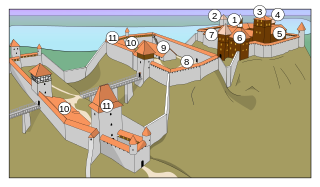 W
WViljandi Castle is 13th Century castle in a Viljandi, Estonia. It was built by the Livonian Order, and construction started in 1224 in place of a former hillfort, which was one of the strongest castles in Livonia. Finally destroyed in the Polish-Swedish wars during the early 17th century, its ruins still stand near the town centre.